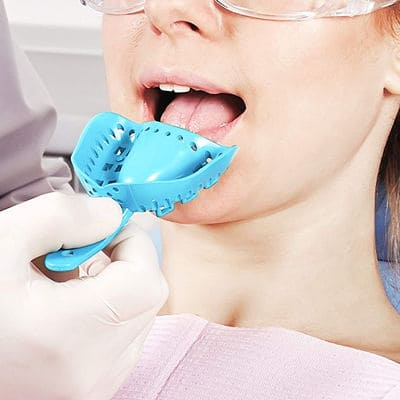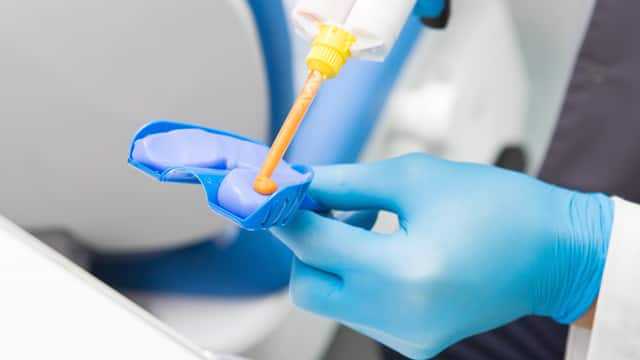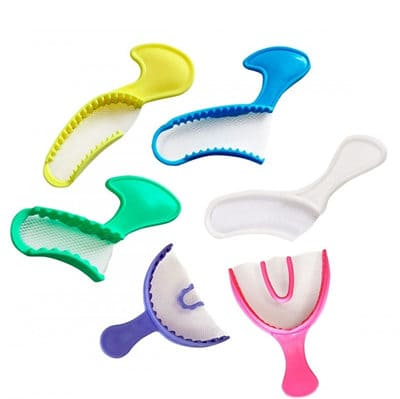What are dental impressions?
A dental impression is taken to get a representation of the mouth and teeth for the fabrication of appliances such as sports guards, crowns and bridges, and dentures.
How Does Dental Impression Make For?
If you’ve ever bitten down into something soft, such as a stick of fudge or a juicy peach, you may have been able to see your bite mark left behind afterward. In fact, this is often how people become aware of a slight misalignment in their front teeth, or a chip they had not yet spotted.
The same principle is used by dentists when repairing your teeth, by taking ‘dental impressions’ to use when creating crowns, dental implants, and bridges. Put simply, a dental impression is a cast or mold taken from your teeth by having you bite down on a horseshoe-shaped tray of soft casting material known as ‘alginate’.

The Importance of Dental Impressions
Taking dental impressions can be done in a few different forms. Sometimes they can be messy from using a plaster material or sometimes they can be taken digitally for patients. Regardless of the method that is used, impressions are taken to get a better understanding of the structure of your teeth and jaws. Have you ever wondered how the impressions are applicable to you? Why are they are necessary for your dentist to do?
A few common reasons are:
- To create a removable partial or complete denture
- To create a conventional dental crown
- To make bridges or fix dentures
- To analyze the relationship of your jaws (orthodontic treatment/ evaluation for oral surgery)
- To create a custom mouthguard (nighttime wear or sportswear)
- To Create custom whitening trays
- To make oral appliances (space maintainers)
- To keep a record of your teeth’ appearance in case of a chip or damage, they can resort to their shape and size.
What Are The Features Of Dental Impressions?
Dental impressions are an impression of the teeth and the mouth to form shapes from which objects are formed.
Dental impressions are used to create a close replica of either your set of teeth or your oral tissue or both. A plastic or metal “horseshoe” shaped tray which comfortably fits into your teeth and gums is chosen and inserted into your mouth. The tray can either be molded for the top, bottom, or both teeth.
Dental impressions come in various types. The technique chosen for a particular circumstance depends on several of the factors, and these include the following:
- First, the recovery type that is desired to be manufactured.
- The clinical competence of each specialist; every doctor has a favorite series of impression techniques.
- Impression techniques can be very different in different parts of the world. In addition, it is very likely that the techniques used in some areas are unknown or not used in others.
Why do you need a great impression?
Having known how impressions are formed and from what plants they are made, now the question is, why do you need a great impression? The following are reasons you might need an impression.
A lack of impression detail can cause misfits
If the impressions do not show the very shape of your teeth and gums, patients may have tight or even loose fits for restorations and prosthetics. This can cause irritation on the site and require another visit.
A bad impression involves inaccurate restorations.
When poor impression techniques are employed, tearing or spaces in the impression margin may occur. This affects the quality of restoration and this results in poor fit, inadequate function, and distortions.
Good impressions are important for dental prosthetics.
The production of well-fitting and effective prosthetic teeth depends on a good and working impression. Impressions that are inaccurate can cause problems for patients, which may require additional visits and more corrective actions.

Dental Impressions Materials
Impression materials are used to copy the teeth and surrounding oral structures by creating a dental impression poured with dental plaster to fabricate a dental cast. This procedure provides a tridimensional and accurate mouth replica, allowing dental work even in the absence of the patient.
Dental models enable dentists to perform a better diagnosis and treatment planning since the teeth can be meticulously visualized and studied from angles that are difficult to see in the patient’s mouth. Particular treatment, such as removable and fixed prostheses, can be executed thanks to dental casts. The final restoration or prosthesis fit depends on how accurately the impression material has recorded the tissue details.
Digital Impressions: Virtually Perfect
Digital impressions represent cutting-edge technology that allows dentists to create a virtual, computer-generated replica of the hard and soft tissues in the mouth using lasers and other optical scanning devices. The digital technology captures clear and highly accurate impression data in mere minutes, without the need for traditional impression materials that some patients find inconvenient and messy. Many patients find digital impressions an easier and more comfortable procedure because traditional impression materials are avoided. The impression information then is transferred to a computer and used to create restorations, often without the need for stone models.
What are Dental Impressions Trays?
Usually made from plastic or metal, dental impression trays hold the impression material while the impression is being created intraorally, and then provide a firm backing to make sure the impression is free of distortions as it finishes setting.
Some impression trays are designed to be reused while others essentially become a part of the impression when it is sent to the dental laboratory. Available in various sizes, trays are designed to capture a specific part of the patient’s anatomy such as a full arch, a quadrant, or opposing dentition. Because different restorative situations require the use of different types of trays, it can be helpful to have a variety of tray sizes and styles on hand.

How many Difference Dental Impression Trays?
There are many different types of Dental impression trays on the market, how should we choose the right dental impression tray? Below we will list a few hor sell dental impression trays.
- Bite Registration Tray
- Dental Plastic Impression Tray
These are also the top sales dental impression trays on Guarddent.com, Our main market is the USA, our factory is producing for Medicom, Defend, Plasdent, and so on.
Hope we have a chance to service you soon.
- Private labels are available.
- Lower MOQ is available.
- Affordable price.
- Premium quality for you to check samples and mass production goods before delivery.
- 1-year warranty when you get the mass production goods.
- Various colors are available
- FDA approved manufacturer
